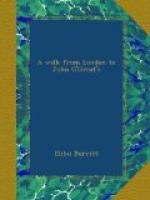The harbor has been dangerous and difficult of access, but of late a great effort has been made to render it more safe and commodious. The Scotch fisheries now yield from 600,000 to 700,000 barrels of herrings annually, employing about 17,000 fishermen; Wick stands first among all the fishing ports of the kingdom. It is a thriving town, well supplied with churches, schools, hotels, banks and printing-offices. Several new buildings are now being erected which will rank high in architecture and add new features of elegance to the place. The population is a vigorous, intelligent, highly moral and well-read community, as I could not fail to notice on attending service on the Sabbath at different places of worship. Wick is honored with this distinction—it assembles a larger congregation of men to listen to the glad Evangel on Sunday than any city of the world ever musters under one roof for the same purpose. It is the out-door church of the fishermen. They sometimes number 5,000 adult men, sea-beaten and sun-burnt, gathered in from mountainous island and mainland all around the northern coasts of Scotland.
Monday, Sept. 28th. The weather was favorable, and I set out on my last day’s walk northward with a sense of satisfaction I could hardly describe. The scenery was beautiful in every direction. The road was perfect up to the last rod; as well kept as if it ran through a nobleman’s park. The country most of the way was well cultivated—oats being the principal crop. Here, almost within sight of the Orkneys, I heard the clatter of the reaping machine, which, doubtless, puts out the same utterance over and upon the sea at Land’s End. It has travelled fast and far since 1851, when it first made its appearance in Europe in the Crystal Palace, as one of the wild, impracticable “notions” of American genius. In Wick I visited a newspaper establishment, and saw in operation one of the old “Columbians,” or the American printing-press, surmounted by the eagle of the Republic. The sewing-machine is in all the towns and villages on the island. If there is not an American clock at John O’Groat’s, I hope some of my fellow townsmen will send one there, Bristol-built. They are pleasant tokens of free-labor genius. No land tilled by slaves could produce them. I saw many large and highly-cultivated farms on these last miles of my walk. The country was proportionately




